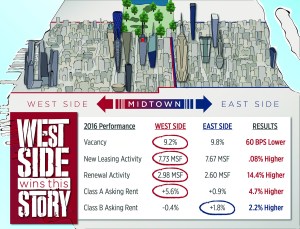Stat of the Week: 60 BPS Lower
By Richard Persichetti November 30, 2016 9:16 am
reprints
 This year, the Midtown vacancy rate jumped 80 basis points to 9.5 percent after hitting a recent low of 8.8 percent at the end of 2015. The rise in vacancy is partially attributed to a 3 percent decline in new leasing activity year over year through October with 14.8 million square feet leased. Despite this, overall average asking rents are up 3.9 percent this year to $79.78 per square foot. Midtown, however, consists of over 242.2 million square feet of inventory, divisible into two distinct submarkets: West Midtown and East Midtown. Splitting up Midtown into West Side and East Side submarkets—every building west and east of Fifth Avenue—uncovers some intriguing results year-to-date. So, let’s take a look at some statistics for both areas and see which side of Midtown can win this battle.
This year, the Midtown vacancy rate jumped 80 basis points to 9.5 percent after hitting a recent low of 8.8 percent at the end of 2015. The rise in vacancy is partially attributed to a 3 percent decline in new leasing activity year over year through October with 14.8 million square feet leased. Despite this, overall average asking rents are up 3.9 percent this year to $79.78 per square foot. Midtown, however, consists of over 242.2 million square feet of inventory, divisible into two distinct submarkets: West Midtown and East Midtown. Splitting up Midtown into West Side and East Side submarkets—every building west and east of Fifth Avenue—uncovers some intriguing results year-to-date. So, let’s take a look at some statistics for both areas and see which side of Midtown can win this battle.
Vacancy Rate: Despite the West Side having a 130-basis-point increase to 9.2 percent this year, it is still lower than the East Side’s 9.8 percent.
Winner: West Side 60 BPS lower
New Leasing Activity: This category was the closest as West Side leasing activity totaled 7.7 million square feet and slightly edged out the East Side by 0.8 percent—a 59,862-square-foot difference.
Winner: West Side 0.8 percent higher
Lease Renewal Activity: the West Side had over 2.9 million square feet of lease renewals signed this year, compared to 2.6 million square feet in the East Side, a 12.6 percent difference.
Winner: West Side 14.4 percent higher
Class A Asking Rent: West Side Class A asking rents jumped 5.6 percent this year to $83.14 per square foot, while East Side grew only 0.9 percent to $85.97 per square foot.
Winner: West Side 4.7 percent higher increase
Class B Asking Rents: West Side Class B average asking rents dipped 0.4 percent this year to $60.29 per square foot, while the East Side had a 1.8 percent increase this year to $59.18 per square foot.
Winner: East Side 2.2 percent higher increase
So, there you have it—Midtown has been dominated by a West Side story this year, and it has outperformed the East Side in four of the five categories.


